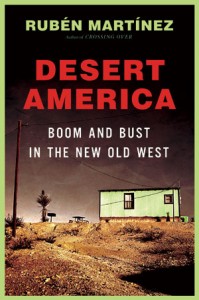Spirituality and politics, stillness and violence — all meet in the ‘land of little rain.’
Los Angeles Times, March 13, 2011
Every Wednesday afternoon, my colleague Douglas Burton-Christie and I try to conjure the desert in a classroom at Loyola Marymount University. We are both bona fide desert rats, but we come to the “land of little rain,” as Mary Austin once called it, from very different places as we teach an interdisciplinary seminar called Into the Desert.
When I first heard Doug talk about his desert, it sounded a bit New Agey to me, a threat to my desert’s historical materialism and political urgency. We ribbed each other. To him I was Rubén, the hotheaded post-colonialist; to me he was Doug, the crunchy latter-day monk.
I flirted with mysticism just out of high school, but I quickly abandoned it. The revolution in El Salvador, my mother’s native country and where I had a large extended family, was televised. Who had time for meditation when there were death squads, guerrillas and refugees to worry about?
Two decades later, over coffee with Doug, I was as political as ever but at the same time also thirsty to explore those matters of the spirit I’d been ignoring. I’d roamed the desert for a long time, but I’d turned away from one of its most enduring traditions.
There are many deserts, I began to realize, in the desert.
The more Doug and I talked, the more we realized that our deserts did not necessarily contradict each other. His scholarship points out that the early desert monks were themselves political as well as spiritual pilgrims. Many of them were small-time farmers stressed by the heavy hand of Roman taxation and the competition for finite resources in the Nile River Valley. They arose during a moment of social crisis, a time not unlike our own. The early monastics practiced anachoresis, a withdrawal from village life to take up solitary contemplation of the divine. They were looking for a better world.
Several of these ideas resonated with “my” desert; today’s migrants might not wander into it intending to fast and pray and do battle with demons, but that is pretty much what they wind up doing as they trek across the wilderness, fleeing from bandits and the Border Patrol.
Our classroom on the third floor of St. Roberts Hall is proving big enough to contain these deserts within the desert. One week the devil is raising dust in St. Anthony’s mind, filling the beautiful emptiness with temptation. The next, we read from Ana Castillo’s quirky and luminous novel “The Guardians,” about a middle-aged Latina struggling to keep her faith and family intact in the murderous borderlands between El Paso and Ciudad Juarez, Mexico. And then we veer to 14th century German theologian Meister Eckhart, imagining a profound spiritual union in the desert where trinities and dualities fall away into “one with One, one from One, one in One, and in One, one everlastingly.” And then we arrive in the mid-20th century to accompany Aldous Huxley on a spirit quest just across the San Gabriel Mountains in the Mojave, invoking Eckhart in his writings even as he agonized over the darkness on the edge of the land: mushroom clouds rising over the Nevada test site.
Like Doug and me, our students struggle to reconcile these disparate deserts: the paradox of a place of perfect stillness and sudden violence, the migrant stumbling across the sand within view of desert-chic resorts.
People in Southern California use the desert in ways that are often at cross-purposes — for quietude and for motocross, for rock climbing and for raves. But within all these, there is the understanding that the desert is a place to transcend our ordinary lives. And in that sense, we are following a very ancient path.

